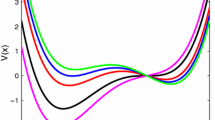Abstract
Relaxation oscillators interacting via models of excitatory chemical synapses with sharp thresholds can have stable anti-phase as well as in-phase solutions. The mechanism for anti-phase demonstrated in this paper relies on the fact that, in a large class of neural models, excitatory input slows down the receiving oscillator over a portion of its trajectory. We analyze the effect of this “virtual delay” in an abstract model, and then show that the hypotheses of that model hold for widely used descriptions of bursting neurons.
Similar content being viewed by others
References
Bélair, J., Holmes, P.: On linearly coupled relaxation oscillations. Quart. Appl. Math. 42, 193–219 (1984)
Bonet, C.: Singular perturbation of relaxed periodic orbits. J. Diff. Eq. 66, 301–339 (1987)
Cronin, J.: Mathematical Aspects of Hodgkin-Huxley Neural Theory. Cambridge: Cambridge University Press 1987
Ellias, S. A., Grossberg, S.: Pattern formation, contrast control, and oscillations in the short-term memory of shunting on-center, off-surround networks. Biol. Cybern. 20, 69–98 (1975)
Ermentrout, G. B.: n:m phase-locking of weakly coupled oscillators. J. Math. Biol. 12, 327–342 (1981)
Ermentrout, G. B., Kopell, N.: Oscillator death in systems of coupled neural oscillators. SIAM J. Appl. Math. 50, 125–146 (1990)
Grasman, J.: Asymptotic Methods for Relaxation Oscillators and Applications. New York: Springer-Verlag 1987
Grossberg, S.: Some physiological and biochemical consequences of psychological postulates. Proc. Natl. Acad. Sci. (USA) 60, 758–765 (1968)
Grossberg, S.: Contour enhancement, short-term memory, and constancies in reverberating neural networks. SIAM 52, 217–257 (1973)
Hansel, D., Mato, G., Meunier, C.: Phase dynamics for weakly coupled Hodgkin-Huxley neurons. Europhys. Lett. 23, 367–372 (1993)
Hodgkin, A. L., Huxley, A. F.: A quantitative description of membrane current and its application to conduction and excitation in nerve. J. Physiol. (London) 117, 500–544 (1952)
Hoppensteadt, F. C.: An Introduction to the Mathematics of Neurons. Cambridge: Cambridge University Press 1986
Hoppensteadt, F. C., Keener, J. P.: Phase locking of biological clocks. J. Math. Biol. 15, 339–349 (1982)
Jansen, M. J. W.: Synchronization of weakly coupled relaxation oscillators. Math. Centre, Amsterdam, Report TW 180 (1978)
Kopell, N., Somers, D.: Waves and synchrony in arrays of oscillators of relaxation and non-relaxation type (in preparation)
Krinskii, V. I., Pertsov, A. M., Reshetilov, A. N.: Investigation of one mechanism of origin of the ectopic focus of excitation in modified Hodgkin-Huxley equations. Biofizika 2, 271–277 (1972)
Mishchenko, E. F., Rozov, N. Kh.: Differential equations with Small Parameters and Relaxation Oscillations. New York: Plenum Press 1980
Mirollo, R. E., Strogatz, S. H.: Synchronization of pulse-coupled biological oscillators. SIAM J. Appl. Math. 50, 1645–1662 (1990)
Morris, C., Lecar, H.: Voltage oscillations in the barnacle giant muscle fiber. Biophys. J. 35, 193–213 (1981)
Neu, J.: Coupled chemical oscillators. SIAM J. Appl. Math. 37, 307–315 (1979)
Nordhaus, T.: Echo-cycles in coupled FitzHugh-Nagumo equations. Ph.D. Thesis, University of Utah 1988
Peskin, C. S.: Mathematical Aspects of Heart Physiology. New York: Courant Institute of Mathematical Sciences Publication 1975
Rand, R. H., Holmes, P. J.: Bifurcation of periodic motions in two weakly coupled van der Pol oscillators. Int. J. Nonlinear Mech. 15, 387–399 (1980)
Rinzel, J.: On repetitive activity in nerve. FASEB Proc. 37, 2793–2802 (1978)
Rinzel, J., Ermentrout, G. B.: Analysis of neural excitability and oscillations. In: C. Koch and I. Segev (eds.): Methods in Neuronal Modeling, pp. 135–169. Cambridge, MA: MIT Press 1989
Schöner, G., Kelso, J. A. S.: A synergetic theory of environmentally specified and learned patterns of movement coordination, II. Biol. Cybern. 58, 81–89 (1988)
Sherman, A., Rinzel, J.: Rhythmogenic effects of weak electrotonic coupling in neuronal models. Proc. Natl. Acad. Sci. (USA) 89, 2471–2474 (1992)
Somers, D., Kopell, N.: Rapid synchronization through fast threshold modulation. Biol. Cybern. 68, 393–407 (1993)
Sperling, G., Sondhi, M. M.: Model for visual luminance discrimination and flicker detection. J. Optic. Soc. Am. 58, 1133–1145 (1968)
Storti, D. W., Rand, R. H.: Dynamics of two strongly coupled relaxation oscillators. SIAM J. Appl. Math. 46, 56–67 (1986)
Tikhonov, A.: On the dependence of solutions of differential equations on a small parameter. Math. Sbornik 22, 193–204 (1948)
Torre, V.: Synchronization on nonlinear biochemical oscillators coupled by diffusion. Biol. Cybern. 17, 137–144 (1975)
Wang, X.-J., Rinzel, J.: Alternating and synchronous rhythms in reciprocally inhibitory models neurons. Neur. Comp. 4, 84–97 (1992)
Wilson, H. R., Cowan, J. D.: Excitatory and inhibitory interactions in localized populations of model neurons. Biophys. J. 12, 1–24 (1972)
Author information
Authors and Affiliations
Additional information
Supported in part by NSF (DMS-8901913), NIMH-47150
Supported in part by NASA (NGT-50497) and the McDonnell-Pew Foundation
Rights and permissions
About this article
Cite this article
Kopell, N., Somers, D. Anti-phase solutions in relaxation oscillators coupled through excitatory interactions. J. Math. Biol. 33, 261–280 (1995). https://doi.org/10.1007/BF00169564
Received:
Revised:
Issue Date:
DOI: https://doi.org/10.1007/BF00169564



